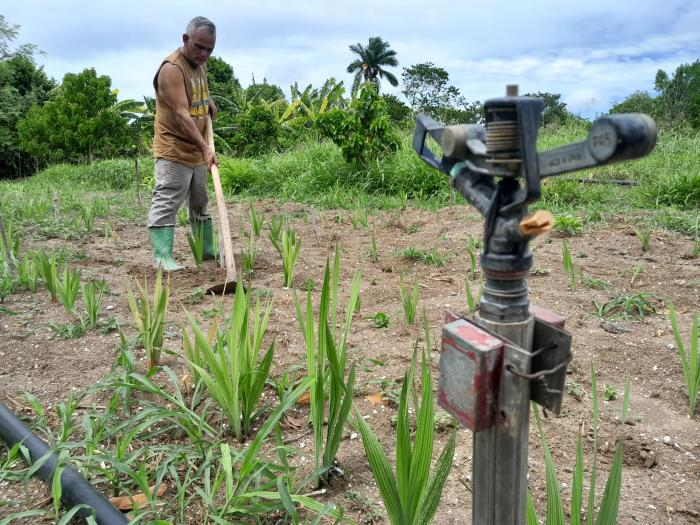
Banes, Holguín, September 2.–Joel Montero García's faith in the magnetic treatment of water, which he uses to irrigate the vegetables he grows and harvests, comes from knowledge obtained in a process of continuous practice. It is an experimental work, individually and together with students of the Agronomy degree, whom he receives, as a tutor, on the Dos Palmas farm.
He was a pioneer in the use of this technology in the territory. He was guided by Physics graduate Rogelio Paredes Pupo, professor at the Municipal University Center (CUM for its Spanish accronym), and one of those in charge of training agricultural engineers there.
In the municipality, the first magnetic device for use in irrigation systems was installed in the 1.03 hectare organoponic farm that he works.
«For the initial test I took four bean beds, each 24 meters long, and installed the device in one. For a time I made meticulous measurements of productive results. In the one benefited with water treated with magnetism, the life cycle of the plants was extended for several more days compared to those of the other three beds, which resulted in a higher yield.
Likewise, he observed that the sprinklers through which the water flows stopped clogging, because the scale produced by the minerals that accumulate when the water is not under the influence of the magnetic devices disappears.
He then extended the technology to lettuce and cucumber, in which the favorable situation described was repeated. Today, in the beds that he dedicates essentially to leafy vegetables, he produces approximately three tons of products per month, the majority destined for social consumption.
«I also apply it in seed treatment. I did the tests with lettuce, with packages equivalent to a handful, which is what I apply per garden bed. I subjected them to periods of four, eight, 12 and 24 hours. "Seeds treated for 12 hours germinated the best, so I introduced that step."
René Dueñas Marrero, a producer associated with the Camilo Cienfuegos Credit and Services Cooperative, in Cano 4, has used this technology for three years on the El Porvenir farm. He started with the bomb fruit or papaya, and obtained a reduction of up to eight days in the time the plants stay in the nursery.
«At the same time I carried out a pre-germination study and, in the bed with magnetically treated water, the seedlings sprouted more quickly, and acquired a size that exceeded the average of those that grew in the other beds. With the acquired strength, they resist diseases and pests better, which makes it possible to reduce the use of chemicals in this crop.
«I have used magnetism on tomato, carrot and cucumber. I produce ornamental plants, and today I am using it to grow gladioli and it is going very well. I only have one hectare under irrigation, with eight devices. "I use another in seed treatment," explains this man, who manages to attend to the sowing and harvesting tasks without abandoning his job as a Physiatrist, in a community polyclinic.
Both producers have the same appreciation: the magnetic treatment of water is not to be idealized as something supreme, but to be seen as a resource that must be used in the set of cultural attentions that contribute to the increase in production on agricultural plots.
NECESSARY AND IMPOSSIBLE GENERALIZATION
The experiences of both producers are part of the actions that have made possible the transfer of Magnetic Technology in Banes Agriculture, a process known as the Magbanes Project, led by Professor Rogelio Paredes Pupo, and made up of professors and students from the degree in CUM agronomy and producers.
Running since 2022, the project responded to a call from the Provincial Delegation of Science, Technology and Environment (Citma), aimed at developing food production. That entity found it consistent with its purposes and approved it, as did the University of Holguín.
«Citma granted us a little more than 500,000 pesos in initial financing. We allocate the money to the purchase of magnetic devices at the National Center for Applied Electromagnetism (CNEA), and to research actions, publications and attention to producers," explains Paredes Pupo.
At that time, there were already solid relations with the CNEA, based in Santiago de Cuba. With that, contacts began in 2018, the result of an initial project, aimed at developing the skills of Agronomy students in the general use of magnetism in the territory's agriculture.
«Through the University of Holguín we bought a magnetic device for water treatment, designed on the basis of a pt 011 magnet. The experiments with different crops showed that there was better germination, development and flowering in the plants to which the water treated with that equipment.
Currently, Magbanes covers 35 farms distributed in all the popular councils of the municipality, in which 278 magnetic devices have been installed, a part acquired by the producers, and another with financing granted by Citma. They can be installed in sprinkler and drip irrigation systems, as well as center pivot machines, and there is one case where they are used in a winder type machine.
When he was a CUM student, the current agricultural engineer Andrés Herrera Batista delved into the use of magnetism in agriculture. Because he carries out a perennial extension work, he delimits that water is not magnetized once it passes through the devices, but is conditioned in a process similar to that which occurs with rainwater when it passes through the earth's magnetic field.
He said that “it is worth applying the technology in any area that has irrigation systems. It is proven that water treated in this way positively influences the physiology of plants and their vegetative processes, until reaching the harvest stage. (Text and photo: Granma)